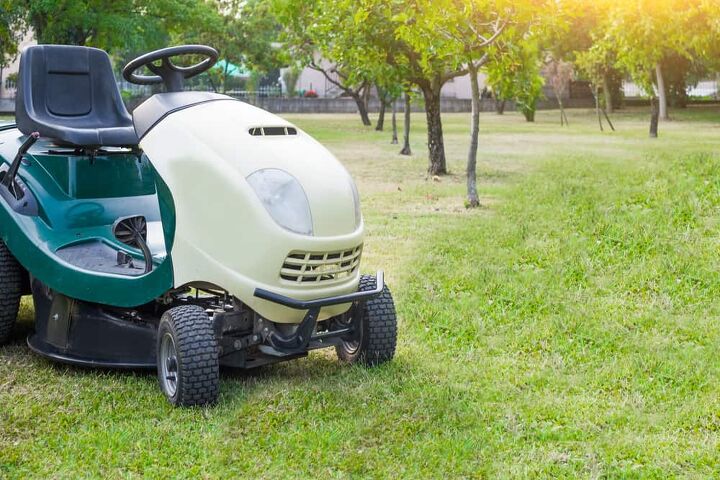Riding Lawnmower Won't Move in Neutral? (Possible Causes & Fixes)

Part of the reason why having a riding lawnmower is so beneficial is that you can cut your grass in half the time it would take with a push model. However, because these machines are relatively complex, they can experience a wider array of issues. One problem you may encounter is that the mower will not move while in neutral. If that happens, it can be tough to maneuver the machine, whether you’re trying to store it or roll it to a new spot.
The most common reasons why a riding mower won’t move in neutral are a seized brake pad or a faulty drive belt. In some cases, the wheels on your machine may also get stuck in place, meaning that they won’t spin freely. You will have to identify the problem and either fix it yourself or get a repair tech to come to your house.
Because these repairs are relatively complicated, we will outline the steps necessary to get your lawnmower back up and running.
Do You Need a Mower Repair Service?
Get free, zero-commitment quotes from pro contractors near you.

Top Reasons Why a Lawnmower Won’t Move in Neutral
Problem 1: A Rusted Brake Pad
One of the most significant problems with using a riding lawnmower is that you have to work hard to keep it clean. Unfortunately, most owners don’t take care of their machines as well as they should, so dirt and grass can collect on virtually every surface. When that happens, water will get onto various metal parts, which can cause them to rust.
Your lawnmower’s brake pads may seize up after continuous use if you aren’t paying attention to them. When that happens, it can be really tough to move the machine in neutral. Fortunately, since riding lawnmowers are much smaller than a car, it is much easier to remove the old pad and replace it with a new one.
The Solution: Replace Your Brake Pad
Depending on the type of make and model you own, the location of the brake pad may be slightly different. Refer to your owner’s manual if necessary. You will need a floor jack, work gloves, needlenose pliers, and a socket wrench set.
Step One: Remove the Rear Left Wheel
If you have ever changed a lawnmower tire before, this step should be easy. Place a hydraulic jack underneath the machine so that the wheel will move freely. Be careful to place the jack on the chassis itself, not on any component that could get damaged.
Lawnmower tires are held in place with a dust cap and a front pin, rather than hex bolts. You will have to remove these pieces to pull the wheel off. It helps to use needlenose pliers for the pin. When removing the tire, keep in mind that there is a small square key that sits on the axle. This key locks the tire in place. It will likely fall out when you’re working, so be sure to keep it with the other pieces.
Step Two: Remove the Brake Assembly
There is just one brake pad on most riding lawnmowers, so you shouldn’t have to do this on both sides. The assembly is next to the wheel. It is held in place by two mounting bolts. Use your socket wrench to loosen the bolts and remove the section. There should be a spring holding it, but you don’t have to disconnect it to change the rotor or pucks.
Step Three: Remove the Brake Pucks
There are two pucks on either side of the rotor. When inspecting them, you will likely notice that they are rusted or dirty. All you have to do is pop them out. You will need to slide the rotor off to reach the second one. If your brake rotor is rusted or damaged, you will have to replace that as well.
Step Four: Insert New Pucks
Be sure that you replace these components with the right size and model number. Once the rear puck is positioned, hold it in place with the rotor. Behind the front puck is two pins and a backing piece. Make sure that these parts are inserted correctly before re-installing the assembly. They can come loose or fall out while you’re working.
Step Five: Reinstall the Brake Assembly
You might have to hold the puck in place until the whole piece is secure. Use the bolts to tighten the assembly so that it will work properly.
Step Six: Replace the Tire
If your axle is facing downward, it can be tough to hold the key in place when putting the wheel on. We recommend turning the axle so that the key can rest on top. Slide the tire onto the key and secure it with the mounting pin. You may have to slide the spacers and washers back before installing the tire.
Bonus: Adjust Your Brake Tension
There is a bolt on the brake assembly that is held in place with a cotter pin. This bolt allows you to adjust your brake tension. All you have to do is turn it clockwise to make it tighter, or counterclockwise to loosen it. You will have to remove the pin first, and then use a socket wrench to make any adjustments. Don’t forget to reinsert the pin afterward. You will also have to turn the ends of the pin so that it will stay in place.
Problem 2: A Worn or Cracked Drive Belt
If your lawnmower won’t move in neutral, it may not move while in drive or reverse. If that is the case, the drive belt may be to blame. This belt is what connects the crankshaft to the wheels, so if it isn’t engaging correctly, you won’t get any kind of movement.
The Solution: Replace Your Drive Belt
This repair is quite complicated, particularly if you aren’t comfortable working on your mower’s engine. Unless you know what you’re doing, we recommend taking your machine to a repair shop or having a technician come to your house. The steps involved with this project include:
- Removing the Cutting Deck
- Removing the Battery and Housing
- Replacing the Belt
Since the drive belt is such an integral part of your machine, you cannot afford to install it incorrectly. If that does happen, you could ruin the new belt or cause damage to some of the internal components. Check out this guide: How To Change The Drive Belt On A Troy-Bilt Horse Riding Mower.
Problem 3: A Stuck Lawnmower Wheel
As we mentioned, various lawnmower components can rust and seize, thanks to the dirt and debris caused by cutting the grass. In some cases, a tire might get stuck in place. When that happens, it won’t spin at all, even when the mower is engaged.
The Solution: Unstick the Wheel
Before doing anything, be sure to lift the machine on a hydraulic jack. This will allow you to work more freely, and it will ensure that you can pull the wheel off easily.
Hopefully, all it will take is some penetrating oil to loosen the tire so that it will slip off. You will need to spray the oil on both sides of the wheel and let it sit for about 20 or 30 minutes. You may have to do this a couple of times for it to work. In extreme cases, you might have to let the oil sit for a couple of hours.
Using a rubber mallet to loosen the wheel can help, but you don’t want to hit it too hard, If you do, then you might wind up breaking the axle, which will create a whole new set of problems.
If the oil doesn’t seem to be doing anything, you might have to heat the metal rim. Since metal expands when hot, doing this should give you enough space between the rim and the axle so that you can pull the tire off. An acetylene torch will be ideal for this since it will deliver even heat to the surface of the rim. If you don’t have a torch, we recommend taking the mower to a repair shop so that they can get it done.
You can find out more about how to unstick a lawnmower wheel here.
Do You Need a Mower Repair Service?
Get free, zero-commitment quotes from pro contractors near you.

Related Questions
What if my mower won’t move in drive or reverse?
If you recently changed the tire, you are likely missing the metal key that attaches the wheel to the axle. Find this key and reinsert it and that should fix the problem. Otherwise, the problem is likely the drive belt.
My mower moves when the engine is on. Does it have to move in neutral?
Although you might not need the mower to move in neutral, its inability to do so is likely a symptom of a more serious problem. So, the sooner you can address it, the less likely that you’ll have a more expensive repair later on.
Related Guides

We are a team of passionate homeowners, home improvement pros, and DIY enthusiasts who enjoy sharing home improvement, housekeeping, decorating, and more with other homeowners! Whether you're looking for a step-by-step guide on fixing an appliance or the cost of installing a fence, we've here to help.
More by Upgraded Home Team













![The 5 Best Angle Grinders – [2022 Reviews & Buyer's Guide]](https://cdn-fastly.upgradedhome.com/media/2023/07/31/9071326/the-5-best-angle-grinders-2022-reviews-buyer-s-guide.jpg?size=350x220)
![10 Best Scroll Saws for 2022 [Ultimate Reviews & Buyer's Guide]](https://cdn-fastly.upgradedhome.com/media/2023/07/31/9070684/10-best-scroll-saws-for-2022-ultimate-reviews-buyer-s-guide.jpg?size=350x220)












